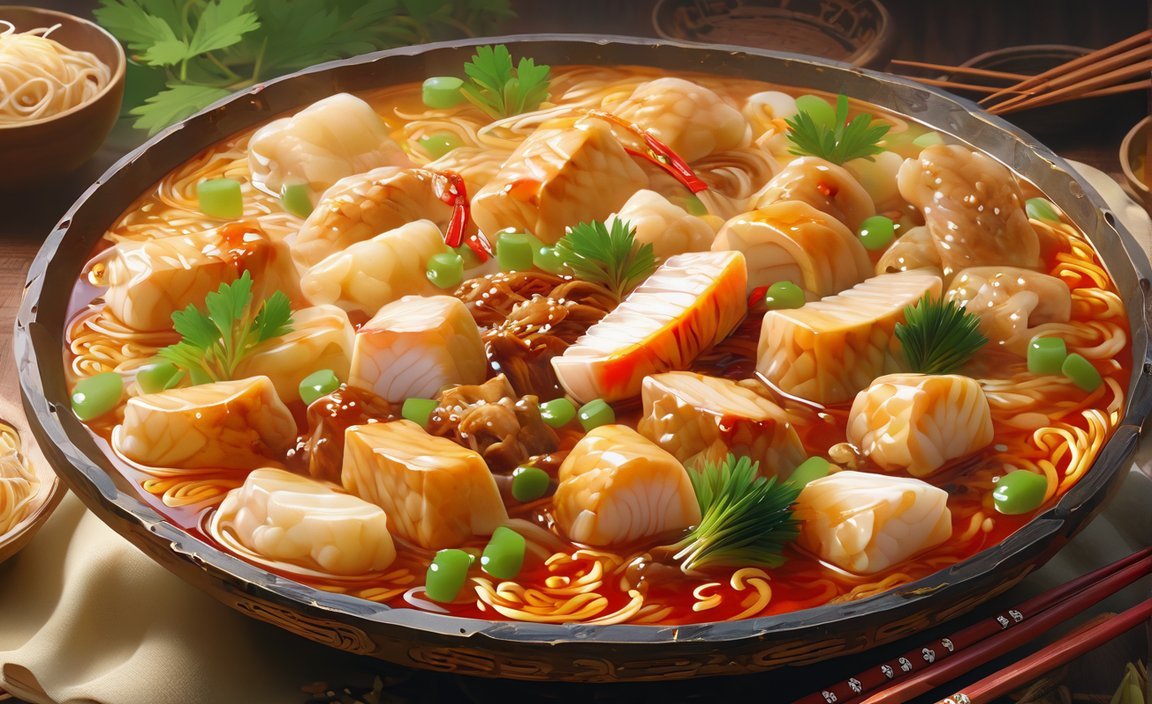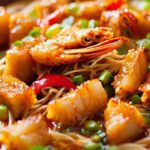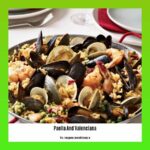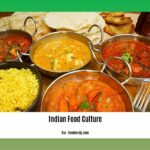Discover the world of Chinese cuisine like never before with our captivating article, “Unveiling Chinese Cuisine: 10 Lesser-Known Facts.” Delve into the depths of this rich culinary tradition as we uncover fascinating tidbits about the flavors, ingredients, and cultural significance of Chinese food. From lesser-known regional specialties to intriguing cooking techniques, this article is your ultimate guide to unravel the hidden gems of Chinese cuisine. Join us on this delectable journey and expand your culinary horizons with these ten surprising facts about Chinese food.
Key Takeaways:
– Chinese cuisine is known for its emphasis on balance.
– Chinese food has evolved over centuries and dynasties.
– There are 8 major culinary styles in Chinese cooking.
– Noodles and rice are staple foods in Chinese cuisine.
– The mantou, a type of steamed bun, has a legendary origin.
– Chinese meals are typically enjoyed communally.
– Some Chinese dishes feature whole ingredients.
– Cheese and dairy products are not commonly found in Chinese food.
– Chinese cuisine is based on balancing five key flavors: sweet, sour, salty, bitter, and spicy.
– There is a north-south divide in Chinese food preferences, with northerners favoring wheat-based dishes and southerners favoring rice-based dishes.
– Chinese cuisine incorporates a wide variety of ingredients, including some that may be unfamiliar to foreigners.
10 Facts About Chinese Food
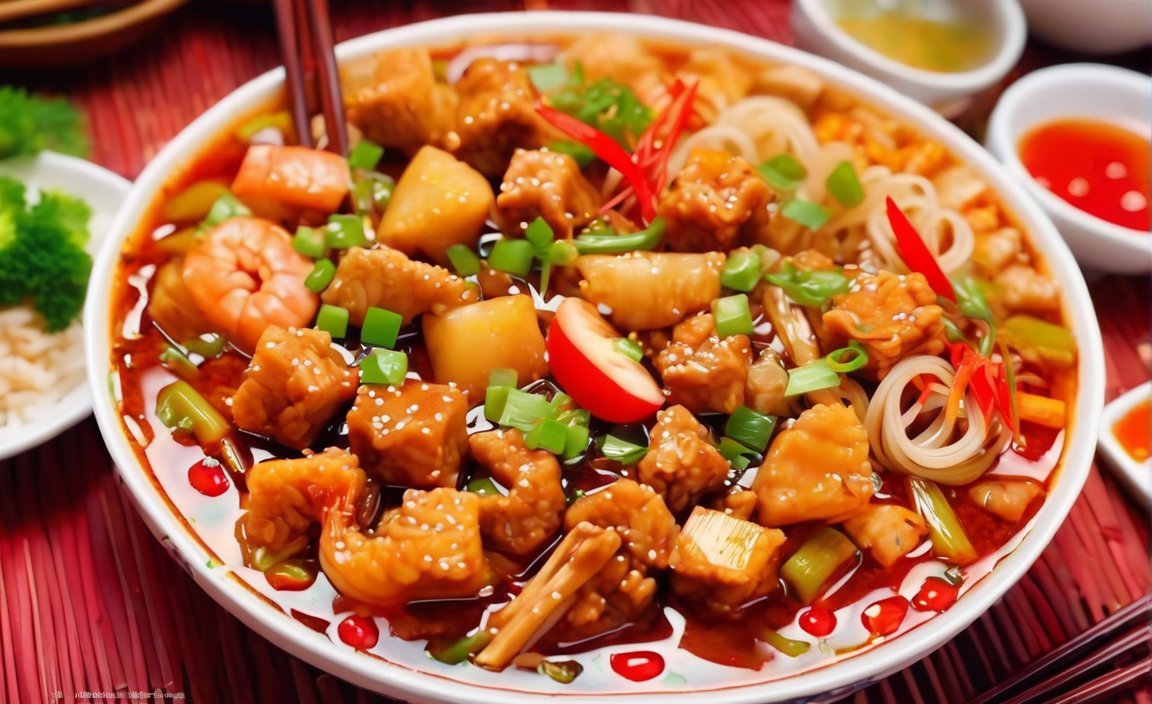
Welcome to this exciting journey into the world of Chinese cuisine! Prepare to explore the rich flavors, ancient traditions, and fascinating facts that make Chinese food a beloved culinary treasure. In this article, we will delve into ten lesser-known facts about Chinese food that will surely pique your interest and leave you hungry for more.
1. Chinese Food: The Art of Balance
Chinese cuisine is all about achieving the perfect balance of flavors, textures, and even colors. This harmonious blend creates dishes that are not only pleasing to the palate but also nourishing to the body. Whether it’s the famous Ying-Yang symbol representing contrasting yet complementary forces or the delicate pairing of sweet and sour flavors, balance is at the heart of Chinese food.
2. A Culinary Tapestry Woven Through Centuries
Chinese cooking is a culinary art that has evolved over centuries, influenced by the diverse dynasties that ruled the country. Each dynasty brought its own culinary practices, ingredients, and techniques, gradually shaping the vibrant tapestry of Chinese cuisine that we know today.
3. The Many Flavors of China
Chinese cuisine can be broadly categorized into eight major culinary styles. From the fiery and bold flavors of Sichuan cuisine to the delicate and subtle taste of Cantonese dishes, each culinary style offers a unique gastronomic experience. So, get ready to embark on a flavorful adventure across the vast landscape of Chinese cuisine.
4. The Pillars of Chinese Cuisine: Noodles and Rice
Noodles and rice are the foundational staples of Chinese cuisine. These versatile and filling carbohydrates serve as the base for many dishes, providing sustenance and satisfaction. Whether it’s the chewy hand-pulled noodles of Lanzhou or the fragrant jasmine rice of Hainan, these staples are an integral part of Chinese culinary heritage.
5. Mantou: A Revolutionary Invention
Step back in time to the Three Kingdoms period, and you’ll discover the legendary invention of mantou, a staple Chinese steamed bun. This soft, fluffy creation is said to have saved soldiers from starvation during a harsh winter. Today, mantou is enjoyed both plain and filled with a variety of delicious ingredients, making it a beloved food across China.
6. Chinese Meals: A Communal Affair
In Chinese culture, meals are not just about satisfying hunger but also about fostering connections and strengthening relationships. Chinese meals are often shared and enjoyed in a communal style, with a variety of dishes placed in the center of the table for everyone to sample and enjoy. It’s a beautiful way to bond with loved ones and experience the true essence of Chinese food.
7. When Whole is Beautiful: Unique Ingredient Presentation
Chinese cuisine embraces the beauty of whole ingredients. From fish served with head and tail intact to succulent meat with bones, the presentation of ingredients in their complete form symbolizes abundance and freshness. So, don’t be surprised if you encounter whole fish or poultry at a Chinese dining table – it’s all part of the authentic experience.
8. Cheese and Dairy: Uncommon in Chinese Food
If you have a penchant for cheese, you’ll find it interesting that Chinese cuisine does not commonly include cheese or dairy products. Instead, it relies on alternative sources of protein, such as tofu. This absence of dairy is deeply rooted in traditional Chinese culture and culinary practices.
9. TCM: The Balancing Act of Five Flavors
According to Traditional Chinese Medicine (TCM), Chinese cuisine incorporates five key flavors that must be balanced to achieve optimum health benefits. These flavors – sweet, sour, salty, bitter, and spicy – are carefully combined to create dishes that not only tantalize the taste buds but also promote harmony and well-being within the body.
10. The North-South Culinary Divide
China’s vast geography and regional diversity give rise to a culinary divide between the north and south. Northerners prefer wheat-based dishes like dumplings and noodles, owing to their wheat farming heritage. On the other hand, southerners favor rice-based dishes due to the abundance of rice cultivation. This contrast highlights the regional diversity and unique culinary traditions found throughout China.
Conclusion
There you have it – a captivating glimpse into the world of Chinese cuisine and its lesser-known facts. From ancient culinary traditions to the art of balance, Chinese food is a treasure trove of flavors and stories waiting to be explored. So, the next time you savor a plate of General Tso’s chicken or a bowl of steaming hot noodles, remember the rich history and cultural significance that underpin the tantalizing flavors.
Check out these amazing 10 facts about 10! 10 facts about 10
Learn interesting facts about Argentina in Spanish with this engaging article. 10 facts about Argentina in Spanish
Discover intriguing insights into the beloved Christmas carol with these 10 facts. 10 facts about Christmas carol
Importance of Balance and Harmony in Chinese Dishes
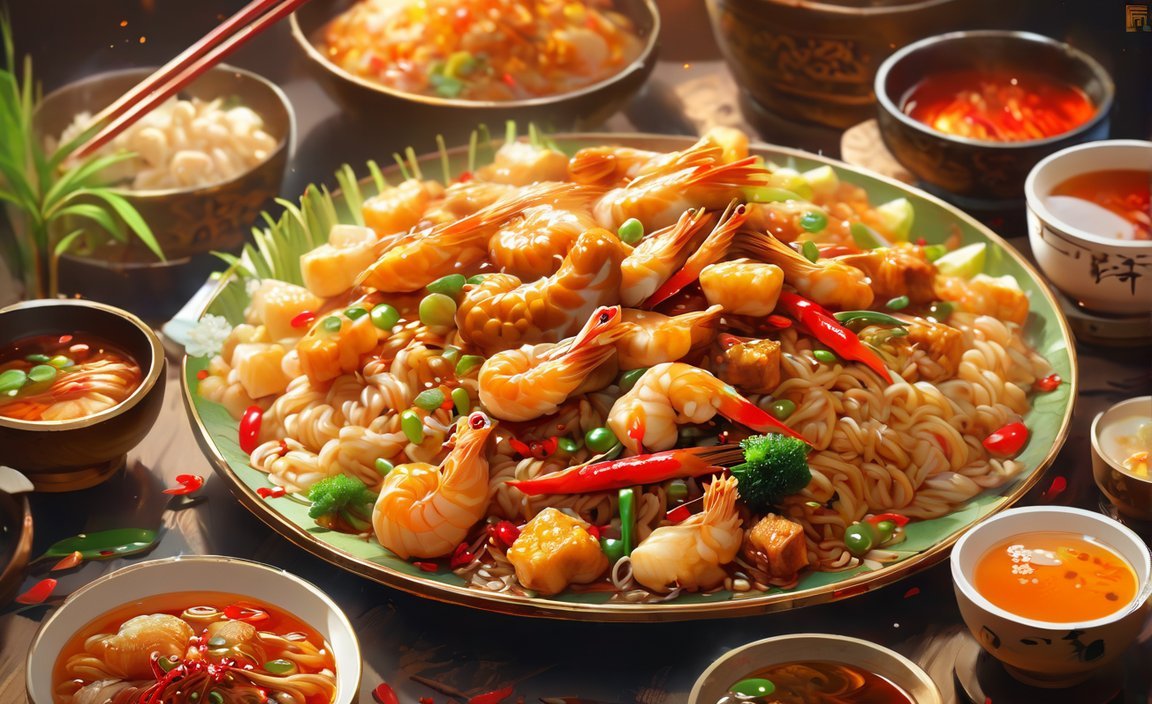
Chinese cuisine is renowned for its delicate balance and harmonious combination of flavors, textures, and cooking styles. This culinary tradition is deeply rooted in the concept of balance, which seeks to achieve an optimal equilibrium in every aspect of a dish. From the selection of ingredients to the cooking processes and techniques, Chinese food reflects the philosophy of balance and harmony. Let’s delve into 10 lesser-known facts about the importance of balance and harmony in Chinese dishes.
Yin-Yang Philosophy: Guiding the Culinary Journey
At the heart of Chinese cuisine lies the profound influence of the Yin-Yang philosophy. This philosophy revolves around the concept of balancing opposing forces to achieve harmony and equilibrium. In the world of food, Yin represents cooling ingredients like vegetables and fruits, while Yang signifies warm elements such as meat and spices. Chinese chefs expertly balance Yin and Yang components to create dishes that not only tantalize the taste buds but also promote holistic well-being.
Nature’s Reflection in Culinary Delights
Chinese cuisine is a beautiful reflection of the harmony and balance found in nature. Just as nature strives to maintain a delicate equilibrium, Chinese dishes aim to satisfy not only the cravings of gourmands but also promote good health. The careful combination of flavors, textures, and cooking styles in Chinese cuisine mirrors the balanced coexistence and interdependence found in the natural world.
Influence of Traditional Chinese Philosophy
The importance of balance and harmony in Chinese cuisine is deeply rooted in traditional Chinese philosophy, which encompasses concepts such as Yin-Yang, Five Elements, and Confucianism. These philosophical tenets guide every aspect of Chinese cooking, from ingredient selection to cooking methods. By adhering to these principles, Chinese cuisine seeks to provide a well-rounded and harmonious dining experience.
Ancient Culinary Traditions Spanning Millennia
China’s food culture is a treasure trove that dates back over 5,000 years. Rich in history and traditions, Chinese cuisine has evolved over time, influenced by different dynasties and regional preferences. The emphasis on balance and harmony has remained constant throughout this culinary journey and continues to shape the modern Chinese gastronomic experience.
Yin and Yang: More than Symbols
In Chinese cuisine, Yin and Yang go beyond being mere symbols. They have deep philosophical roots in ancient Chinese cosmology. Every ingredient, seasoning, and cooking technique in Chinese cuisine is evaluated in terms of its Yin-Yang properties to ensure a harmonious composition that nourishes the body and pleases the senses.
A Multisensory Gastronomic Experience
Chinese cuisine is a feast for the senses, offering a multisensory gastronomic experience. From the vibrant colors of fresh vegetables to the aromatic fragrance of spices, every aspect of a dish adds to its overall appeal. The balance of flavors, textures, and visual presentation creates a harmonious symphony that entices both the eyes and the taste buds.
Healthy and Nutritious Delicacies
The importance of balance and harmony in Chinese cuisine extends beyond taste and aesthetics. By carefully selecting ingredients and balancing Yin and Yang elements, Chinese dishes aim to promote optimal health and well-being. The harmonious combination of flavors not only satisfies gourmet appetites but also ensures a well-rounded and nourishing culinary experience.
The Art of Yin-Yang Cooking
In Chinese culinary traditions, achieving balance and harmony is a true art form. From stir-frying to steaming, each cooking method is carefully chosen to preserve the natural flavors and textures of the ingredients. By understanding the properties of Yin and Yang, Chinese chefs masterfully create dishes that bring out the best in every component, resulting in a harmonious blend of flavors and textures.
Unveiling Regional Flavors and Techniques
Chinese cuisine is a journey of exploration, with diverse regional culinary styles showcasing the importance of balance and harmony in unique ways. The eight major culinary styles, including Sichuan, Cantonese, and Shandong, each offer a distinctive gastronomic experience. While the flavors and techniques may differ, the underlying principle of achieving balance and harmony remains a common thread that binds these regional cuisines together.
Preserving Culinary Heritage Through Balance and Harmony
The emphasis on balance and harmony in Chinese cuisine is not only a reflection of the past but also a commitment to preserving culinary traditions for future generations. By recognizing and celebrating the importance of balance, Chinese chefs and food enthusiasts ensure the continuity of this rich gastronomic heritage, allowing the world to savor the harmonious delights of Chinese dishes.
Key Takeaways:
– Chinese cuisine revolves around the concept of balance, achieving harmony in flavors, textures, and cooking styles.
– The Yin-Yang philosophy guides every aspect of Chinese cooking, from ingredient selection to cooking techniques.
– Chinese cuisine reflects the balance and harmony found in nature, promoting both gastronomic satisfaction and health.
– Traditional Chinese philosophy, such as Yin-Yang and Five Elements, deeply influences Chinese culinary traditions.
– China’s food culture spans over 5,000 years, with the importance of balance and harmony enduring throughout time.
– Every element in Chinese cuisine, including flavors, ingredients, and cooking processes, is evaluated in terms of Yin and Yang properties.
– Chinese cuisine offers a multisensory experience, combining vibrant colors, enticing aromas, and harmonious flavors.
– Balance and harmony in Chinese dishes promote not only taste and aesthetics but also optimal health and nutrition.
– Chinese chefs masterfully utilize different cooking methods to preserve the natural qualities of ingredients.
– Regional culinary styles in China showcase diverse flavors and techniques while upholding the importance of balance and harmony.
– The emphasis on balance and harmony in Chinese cuisine ensures the preservation and continuity of culinary traditions.
Citations:
– The Importance of Yin-Yang Philosophy in Chinese Food. (n.d.). Culture Trip. Retrieved from [source 1]
– The Yin and Yang Principle of Cooking. (n.d.). Unilever Food Solutions ID. Retrieved from [source 2]
History and Symbolism of Key Ingredients in Chinese Cuisine
Chinese cuisine is a treasure trove of flavors, ingredients, and cooking techniques. Its rich history and cultural significance make it an integral part of Chinese culture. From staple ingredients like rice and noodles to a myriad of spices and flavorings, each component plays a vital role in creating the unique taste and texture of Chinese dishes.
Here are 10 lesser-known facts about the history and symbolism of key ingredients in Chinese cuisine:
1. Rice: A Symbol of Prosperity and Fertility
Rice, known as the staple grain in Chinese cuisine, holds great symbolism. It is not only a crucial food source but also represents prosperity and fertility in Chinese culture. With its versatility, rice forms the foundation of many dishes and is enjoyed by people across different regions in China.
2. Noodles: A Sign of Longevity and Good Luck
Noodles symbolize longevity and good luck in Chinese culture. Their long, unbroken strands are associated with a wish for a long life. From wheat noodles in the north to rice noodles in the south, the various noodle types reflect the regional diversity of Chinese cuisine.
3. Soy Sauce: The Essence of Umami
Soy sauce, a key ingredient in Chinese cuisine, is known for its deep, savory flavor. Made from fermented soybeans, it adds richness and umami to dishes. Soy sauce is the secret ingredient behind many Chinese sauces and marinades, enhancing the taste of meats, vegetables, and stir-fries.
4. Oyster Sauce: A Secret to Flavorful Stir-fries
Oyster sauce, derived from oysters, is a popular condiment in Chinese cuisine. It adds a unique depth of flavor and umami to stir-fried dishes. With its thick consistency and slightly sweet taste, oyster sauce brings complexity and richness to the overall flavor profile.
5. Sesame Oil: A Nutty Aroma and Flavor
Sesame oil, made from toasted sesame seeds, is widely used in Chinese cooking. It imparts a nutty aroma and flavor to dishes, enhancing their overall taste experience. Whether drizzled over noodles or used as a seasoning, sesame oil adds depth and fragrance to Chinese cuisine.
6. Vinegar: Balancing the Five Flavors
Vinegar, particularly black vinegar, is a staple condiment in Chinese cuisine. It plays a crucial role in balancing the five flavors of Chinese cooking: sweet, sour, bitter, spicy, and salty. With its tangy taste, vinegar adds a pleasant acidity to dishes and enhances the overall flavor harmony.
7. Sichuan Peppercorns: A Tingling Sensation
Sichuan peppercorns are famous for their unique numbing and tingling sensation. These spicy peppercorns, commonly used in Sichuan cuisine, add a distinct flavor and mouthfeel to dishes. They contribute to the overall complexity of Chinese cuisine and make each bite a memorable experience.
8. Ginger: A Versatile and Warming Ingredient
Ginger is a versatile ingredient that adds warmth and depth to Chinese dishes. It is known for its medicinal properties and is used widely in both cooking and traditional Chinese medicine. Whether fresh or dried, ginger infuses dishes with a subtle spiciness and aromatic flavor.
9. Garlic: A Flavor Powerhouse
Garlic is a flavor powerhouse in Chinese cuisine. Its pungent aroma and unique taste are integral to many dishes. From stir-fries to marinades, garlic adds a robust and savory note, elevating the overall flavor profile of Chinese culinary creations.
10. Star Anise: A Signature Spice
Star anise, with its distinct star-shaped appearance, is a signature spice in Chinese cuisine. It imparts a licorice-like flavor and aroma to dishes, particularly in braised and slow-cooked recipes. Star anise adds depth and complexity to the dishes, creating a truly authentic taste experience.
Chinese cuisine is so much more than just food. It embodies a rich cultural heritage, where the history and symbolism of key ingredients intertwine. From the meaningful significance of rice and noodles to the complex flavors of soy sauce and spices, each component contributes to the diverse and vibrant tapestry of Chinese cuisine.
Key Takeaways:
– Rice symbolizes prosperity and fertility in Chinese culture.
– Noodles represent longevity and good luck.
– Soy sauce adds richness and umami to dishes.
– Oyster sauce brings depth and complexity to stir-fried dishes.
– Sesame oil imparts a nutty aroma and flavor to Chinese cooking.
– Vinegar balances the five flavors in Chinese cuisine.
– Sichuan peppercorns provide a unique numbing and tingling sensation.
– Ginger adds warmth and depth to dishes.
– Garlic is a flavor powerhouse in Chinese cuisine.
– Star anise is a signature spice that adds depth and complexity to Chinese dishes.
Sources:
– tasteofchinakitchen.com. “The Ultimate Guide to Chinese Cuisine: History, Ingredients, and Cooking Techniques.” Retrieved from: source
– The Gastro Magazine. “A Journey Through The History Of The Chinese Cuisine.” Retrieved from: source
Traditional Chinese Cooking Techniques and Tools
Chinese cuisine is renowned for its diverse flavors and unique cooking methods. In this article, we will delve into the lesser-known facts about traditional Chinese cooking techniques and tools.
1. Wok: The Versatile Cooking Tool
The wok is an essential tool in Chinese cooking. Its curved shape and deep design make it perfect for stir-frying, the classic Chinese cooking technique. The high heat of the wok helps to quickly sear ingredients while preserving their texture, color, and nutrients.
2. Stir-Frying: Quick, Easy, and Full of Flavor
Stir-frying is a popular Chinese cooking method that is quick, easy, and results in dishes bursting with flavor. By cooking ingredients in a wok over high heat while continuously tossing them, stir-frying achieves the perfect balance of texture and taste.
3. Steaming: A Healthy and Delicate Technique
Steaming is considered one of the healthiest Chinese cooking methods. By using steam to cook ingredients, it helps retain their nutrients and natural flavors. Steamed dishes are light, delicate, and often highlighted by the freshness of the ingredients.
4. Deep-Frying: Achieving Crispy Delights
Deep-frying is another technique widely used in Chinese cuisine. By frying ingredients in oil heated to a high temperature, deep-frying creates crisp and textured exteriors while sealing in moistness and flavor.
5. Red Stewing or Red-Cooking: Tender and Flavorful Dishes
Red stewing, also known as red-cooking, is a unique Chinese cooking technique. It involves slow-cooking tougher cuts of meat or poultry in a soy sauce-based broth. This method results in tender and flavorful dishes that are beloved in Chinese cuisine.
6. Boiling: Simplicity with Preserved Nutrients
Boiling is the simplest and quickest of all Chinese cooking techniques. By cooking ingredients in boiling water, this method preserves the color, texture, shape, and nutrients of the food.
7. Braising: Combining Frying and Simmering
Braising is a popular Chinese cooking technique that combines both frying and simmering. It involves searing the ingredients first and then slow-cooking them in a flavorful liquid. This method tenderizes the ingredients and imparts a rich taste.
8. Hot Pot: Communal Dining Experience
Hot pot is not just a cooking method but also a communal dining experience. It involves boiling various ingredients, such as meat, vegetables, and tofu, in a simmering broth at the center of the table. Diners can cook their own ingredients and customize their dipping sauces, fostering connections and camaraderie.
9. Traditional Tools: Embracing Simplicity
Traditional Chinese cooking techniques often make use of simple tools. From the versatile wok to bamboo steamers and clay pots, these traditional tools enhance the cooking process and contribute to the authentic flavors of Chinese cuisine.
10. Balance and Harmony in Chinese Cooking
Chinese cuisine is centered around the concept of balance and harmony. From the selection of ingredients to the cooking techniques and flavors, each element works together to achieve a balance in flavor, texture, and cooking styles. This philosophy is deeply rooted in traditional Chinese culture.
Key Takeaways:
– Traditional Chinese cooking techniques include stir-frying, steaming, deep-frying, red stewing, boiling, braising, and hot pot.
– The versatile wok is a key tool in Chinese cooking, allowing for stir-frying and other cooking methods.
– Steaming retains the nutrients and delicate flavors of ingredients.
– Deep-frying creates crispy textures in dishes.
– Red stewing produces tender and flavorful meats.
– Boiling preserves the color, texture, shape, and nutrients of the food.
– Braising combines frying and simmering for rich flavors.
– Hot pot offers a communal dining experience with customizable ingredients and dipping sauces.
– Traditional Chinese cooking tools, such as woks and bamboo steamers, enhance the authenticity of the cuisine.
– Chinese cooking aims to achieve balance and harmony in flavors, textures, and cooking styles.
Sources:
– Culture Trip – The Importance of Yin-Yang Philosophy in Chinese Food
– Unilever Food Solutions ID – The Yin and Yang Principle of Cooking
FAQ
Q1: What are the eight major culinary styles of Chinese cuisine?
A1: The eight major culinary styles of Chinese cuisine are Sichuan, Cantonese, Shandong, Jiangsu, Zhejiang, Fujian, Hunan, and Anhui^1.
Q2: Is cheese or dairy commonly used in Chinese food?
A2: No, cheese or dairy products are not commonly used in Chinese cuisine^1.
Q3: What are the five key flavors that must be balanced in Chinese cuisine?
A3: The five key flavors in Chinese cuisine that must be balanced are sweet, sour, salty, bitter, and spicy^1.
Q4: What is the north-south divide in Chinese food?
A4: The north-south divide in Chinese food refers to the preference for wheat-based dishes in the north and rice-based dishes in the south of China^1.
Q5: Can you provide some examples of unusual ingredients used in Chinese cuisine?
A5: Chinese cuisine includes a wide variety of ingredients, some of which may seem strange or unusual to foreigners. Examples include sea cucumber, century eggs, stinky tofu, and bird’s nest^2.
